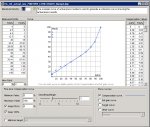Polyprintgirl
Active member
Any ideas on how to keep the shadows open outside of a press compensation curve? We're having trouble keeping our shadows open, they seem dull and muddy.
We are currently applying a press curve; we output round dots; 150 line screens. Our screen angles are 7.5 YEL, 22.5 CY, 52.5 MAG and 82.5 K. Our press is water based. It was suggested to use an elliptical dot for process work, rather than round, because it makes a better rosette.
Our first option will to output at 150L with elliptical dot
Depending on the elliptical dot output, our second option may be to output at 150L round dot with a more open press curve (to open up 3/4 tones-shadows)
Any thoughts or comments on this would be greatly appreciated.
Thanks.
We are currently applying a press curve; we output round dots; 150 line screens. Our screen angles are 7.5 YEL, 22.5 CY, 52.5 MAG and 82.5 K. Our press is water based. It was suggested to use an elliptical dot for process work, rather than round, because it makes a better rosette.
Our first option will to output at 150L with elliptical dot
Depending on the elliptical dot output, our second option may be to output at 150L round dot with a more open press curve (to open up 3/4 tones-shadows)
Any thoughts or comments on this would be greatly appreciated.
Thanks.











